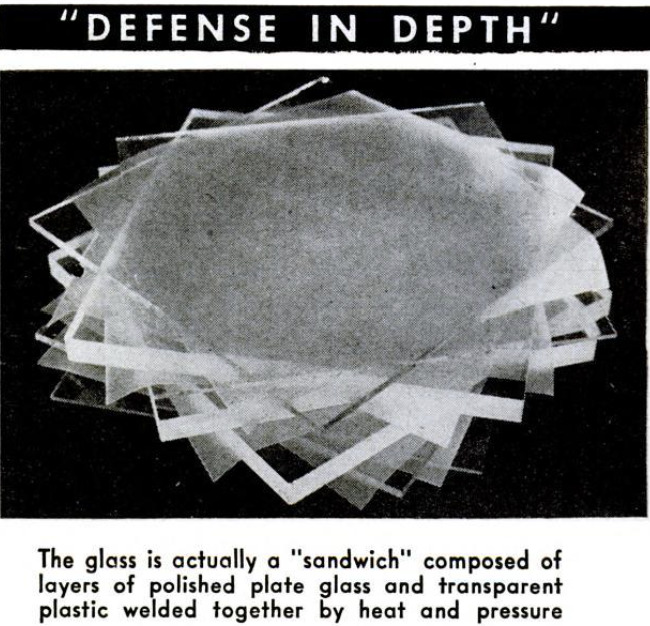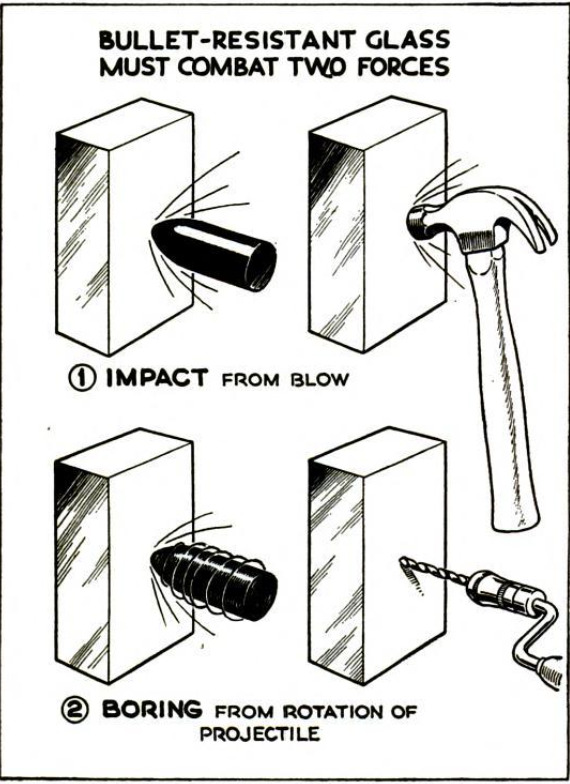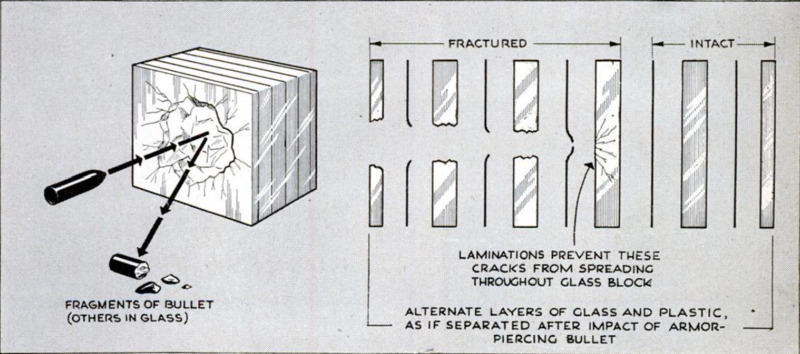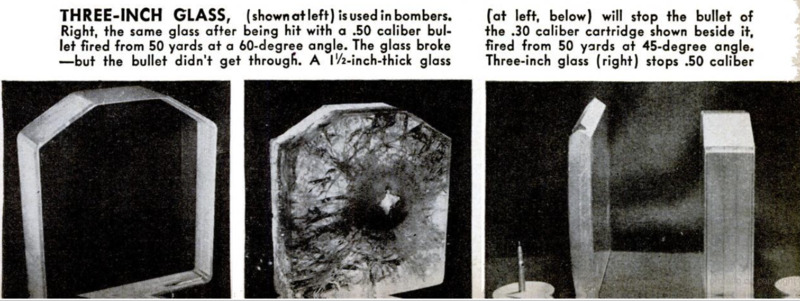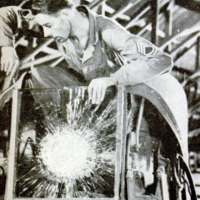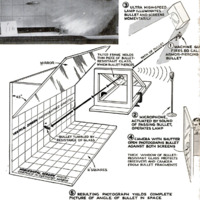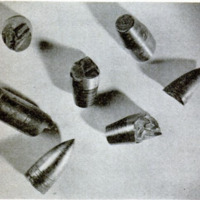-
Title (Dublin Core)
-
Bullet-resistant glass
-
Article Title and/or Image Caption (Dublin Core)
-
Title: Transparent armor...shields for sky fighters
-
Subtitle: Layers of glass and plastic, like your car's safety windows, resist shattering by bullets
-
extracted text (Extract Text)
-
THINGS were getting hot for the rear gun-
ner of an American medium bomber over
Tunisia, one day a few months ago. A Mes-
serschmitt was on his tail, and 20-mm. explo-
sive shells whizzed closer and closer, until
one of them smacked right against his win-
dow. By all the rules, that should have
ended the gunner’s career. The fact is that
he wasn't even scratched.
Incredible as it seems, a piece of glass
saved his life. The window was a typical
installation of a modern aviation material
for protecting combat flyers, which Ameri-
can factories are now turning out on a mass-
production scale. Cautiously, its makers
and the armed forces call it “bullet-resistant
glass.” They emphasize that it was never
intended to stand up against explosive shells,
though it has done so on occasion. What the
manufacturers do say, and rigid Army and
Navy specifications demand, is that a block
of this glass 5% inches thick will stop a .50
caliber armor-piercing bullet, striking head-
on, at a range of only 50 yards. And that
thickness may be considerably reduced if
only oblique hits, by far the more frequent,
are to be guarded against.
In principle, bullet-resistant glass takes
after its ancestor, automobile safety glass.
Both consist of multiple sheets of polished
plate glass, separated by films of transpar-
ent plastic. These intervening layers of elas-
tic material are bonded to the glass by heat
and pressure. They serve to prevent a crack
from spreading through the entire thickness,
confining it to a part of the “sandwich.”
Also, they oppose radial cracking and shat-
tering.
Much depends on the type of plastic used.
The kinds first employed for auto safety
glass had drawbacks, of minor importance
to motorists but serious to airplane crews.
For example, long exposure to sunlight
tended to discolor the plastic—only slightly
in a thin window, but considerably in one of
enough layers to resist bullets. Another dif-
ficulty was that extreme cold made the plas-
tic brittle, robbing it of resiliency and
weakening the bond between layers of glass.
Not long before the war, chemists perfected
a synthetic plastic, known as plasticized
vinyl butyral, which met all objections.
Successfully tried out in automobiles, and
then in armored cars used for transporting
valuables, bullet-resistant glass was fully
developed just in time for war needs, which
now consume the entire supply. After hos-
problem. One square foot of the material,
one inch thick, tips the scale at 13 pounds.
How to make windows as light in weight
as possible, therefore, is a question that has
preoccupied makers and users. One solution
has been to keep down their dimensions and
mount them close to the eyes of a flyer so as
not to restrict his field of vision. A window
as small as a foot square gives the tail gun-
ner of a bomber plenty of view to sight his
weapon. Likewise, a small block of the glass
may be mounted within the cockpit of a
fighter, just in front of the pilot's head.
Front-line observers, reporting on the pro-
portion of air casualties caused by bullets of
various calibers, have helped to show the
minimum of glass thickness consistent with
safety. In the same way, the angle at which
most bullets strike a craft of a given type
has come in for study. According to report,
the Army wanted to find out the chances of
one fighter pilot shooting another while the
two planes approached head-on. Two skilled
pilots took up planes and tried it, just short
of actually shooting. To make sure that
their paths would coincide, they came at each
other with a straight highway for a guide.
With the terrific speed of such planes, both
pilots concluded, the fleeting interval be-
tween coming into range and swerving to
avert a midair collision would have been too
short to get in a single machine-gun burst.
The importance of this finding may be
judged by the fact that if a piece of bullet-
resistant glass 214 inches thick will stop a
bullet heading straight for it, its thickness
may be reduced to 13 inches to turn away
a bullet at 45 degrees, and to 1% inches for
a hit at an angle of 30 degrees with the
glass.
Currently being investigated is the possi-
bility of using two or more blocks of bullet-
resistant glass, with the combined thickness
of a single layer, but set some distance apart
and at an angle to each other. One hoped-
for effect would be to tumble the bullet in
flight, so that it would tend to sideswipe the
second block instead of striking nose first.
Even a deviation as small as five degrees re-
duces the penetrating power of a bullet.
Ultrahigh-speed photographs made in the
Creighton, Pa., research laboratories of the
Pittsburgh Plate Glass Company—reveal
what happens to a bullet after it penetrates
relatively thin sheets of the material
Through a cleverly arranged set-up, a single
picture tells the whole story.
At one end of a basement test range, the |
experimenters fire a single round from a
standard aircraft machine gun, whose mount
is embedded in concrete. The bullet bores
through the piece of glass, 50 yards away.
An instant later, its picture is taken as it
passes a pair of vertical and horizontal
sheets of cardboard ruled with two-inch
squares. To do this, the camera shutter is
left open in the darkened range. A micro-
phone, four feet nearer to the gun than the
camera, picks up the sound of the passing
bullet. This serves as the trigger to set off
an Edgerton-type lamp, which stabs the bul-
let and marked screens with 2/1,000,000 of a
second of illumination.
Studies of the pictures show that an in- |
clined plate tumbles a bullet effectively—
and that even a thin vertical plece of bullet-
resistant glass has some effect. The views
also show that laminated sheets as thin as |
half an inch can rip the copper jacket from
a bullet, and even smash the projectile into
fragments. From such’ fundamental re-
search, advanced arrangements of bullet
resistant glass are expected soon to emerge
that will save the lives of still more airmen.
ALDEN P. ARMAGNAC,
-
Contributor (Dublin Core)
-
Alden P. Armagnac (article writer)
-
Robert F. Smith (photographer)
-
Language (Dublin Core)
-
eng
-
Date Issued (Dublin Core)
-
1944-02
-
pages (Bibliographic Ontology)
-
74-77
-
Rights (Dublin Core)
-
Public Domain (Google digitized)
-
Archived by (Dublin Core)
-
Lorenzo Chinellato
-
Marco Bortolami (editor)
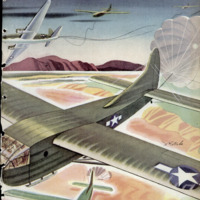 Popular Science Monthly, v. 144, n. 2, 1944
Popular Science Monthly, v. 144, n. 2, 1944


